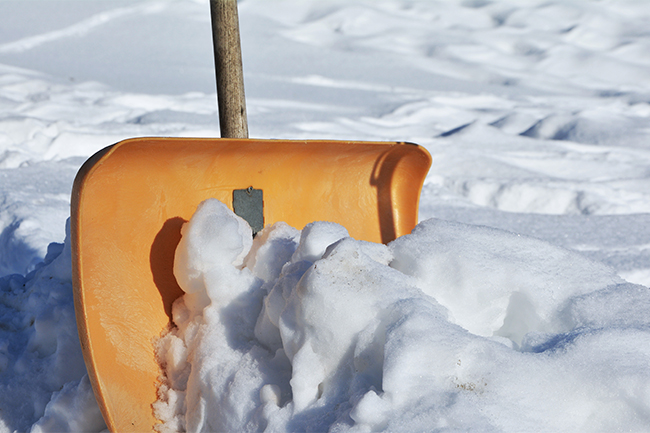How to avoid injuries while shovelling this winter
20 January 2020
Shovelling snow is an inevitable chore for many home and business owners. While it can be thought of as great exercise and a chance to start the day with a breath of fresh air, all too often we associate clearing our driveways and entrances with cold faces and fingers, wet feet and sore muscles. There are ways to make shovelling easier, more pleasant, and safer for your body and health. Here are our top recommendations for avoiding injuries while shovelling this winter. (As for changing your mindset to actually LOVE shovelling, that’s out of our wheelhouse!)
Start with a stretch
As little as 5-10 minutes of light stretching before you get geared up and head outside can help prevent injury and soreness after shovelling snow. Choose stretches that focus on your lower back and hamstrings. If you’re prone to hand cramps, stretch your palms and forearms before and after shovelling.
Get the right shovel for the job
The Canadian Centre for Occupational Health and Safety offers these tips for choosing a shovel in general:
- Weight – a snow shovel should be as light as possible
- Length- when the blade is placed on the ground, the total length (blade plus shaft and handle) should be approximately to elbow height (when arms are at your side)
It’s also important to choose the right blade size and shape depending on the amount and type of snow you’re shovelling. While a longer blade width will clear a bigger surface when pushing light fluffy snow, if it’s too big, it could be impossible to lift wet, heavy snow (not to mention throwing it over the snowbank). Having a variety of sizes of shovel blades can help reduce strain and injury. Many shovels come with ergonomic handles which can make off-season storage more challenging, but reduce the strain on your back and legs when lifting.
Push vs Throw
Throwing snow over high snow banks is one of the easiest ways to get over-exerted, sore, and injured. The CCOH recommends that the throw height should not exceed 1.3 metres (approx 4 feet) and the throw distance just 1 metre (about 3 feet). It’s all fine and well to recommend “push snow instead” but as the winter goes on and the snowbanks grow higher and higher, homeowners and businesses can run out of space to push the snow they’re shovelling from their sidewalks, driveways, and parking spaces.
Get creative, folks! If possible, build in a ramp of snow perpendicular to your driveway so that you can push snow into the centre of your yard. If not a ramp, cut out a staircase through your snowbank so that you’re not forced to throw above your shoulders. A little creativity and planning (and fun with the kids?) can help you keep pushing snow as much as possible instead of risking injury from throwing snow.
Salt + Deicer
Laying salt or deicer products make a big difference in keeping your entranceway safe for visitors and easier for you to maintain during the winter. But knowing how to use salt effectively to treat your driveway, steps, side-walk, and parking lot isn’t necessarily straightforward:
- When should I salt my driveway, before or after it snows?
- How much salt should I use on my front steps?
- What type of salt works in Gatineau weather conditions?
Here are our tips for using salt properly to avoid slips, falls, and injury on your commercial or residential property this winter:
- Shovel away as much snow and ice first so that you can use the bare minimum of salt (excessive salt can damage pavement and asphalt over time)
- Choose the right salt for the temperature – different compounds available in Gatineau will be effective at different temperatures. The lower the air temperature, the higher the chemical compound necessary to melt the snow and ice, so try to use the highest temperature possible for the current weather conditions. At -9 degrees Celsius, you straight rock salt will melt ice with no additional chemicals.
- Lay your salt before a major snowfall so that the lower layers don’t compact into ice.
- Use the power of the sun to activate the salt and shovel after the base layer has become loosened by the melting ice and salt. Once the sun sets and the temperature falls, your freshly melted ice could re-freeze so try to get it while it’s wet.
- Reapply salt after you have shovelled away fresh accumulation of snow.
Remember that salt and deicers can cause skin irritation so be sure to wear gloves when handling. Also keep any metal tools and items away from salted areas to avoid corrosion and rust. Finally, investing in a good exterior door mat will provide you a safe landing space to start applying your salt and also help you remove salt grains from boots before tracking them indoors.
Shovel often or not at all
If you’re able to keep ahead of major snow accumulation in a safe manner (remembering the importance of stretching and choosing the right tools and equipment), try to shovel in short periods throughout the day and evening. Shovelling small amounts of snow might feel like a waste of time and energy, but once it starts to melt into heavy wet snow, is coated with a layer of freezing rain, or freezes solid in the wind, you will regret not getting rid of those first few centimetres of white-and-fluffy that seemed so innocent a few hours earlier but are now a major shovelling job.
If snow has built up or is too heavy for you to safely shovel, DON’T do it! Call in a neighbour or hire a professional snow removal company. Your health and safety aren’t worth the risk of pain, injury and even long-lasting health problems.
P.S. Soaking for 15-30 minutes in a moderately warm bath with 2 cups of dissolved epsom salts is a great way to help your shovelling muscles to recover and get ready to do it all over again tomorrow. Our favourite scent is lavender!
Pavage Massie provides reliable and quick snow removal services for residential buildings and commercial and industrial premises in Gatineau and the Outaouais region. Reach out today for a free estimate.



